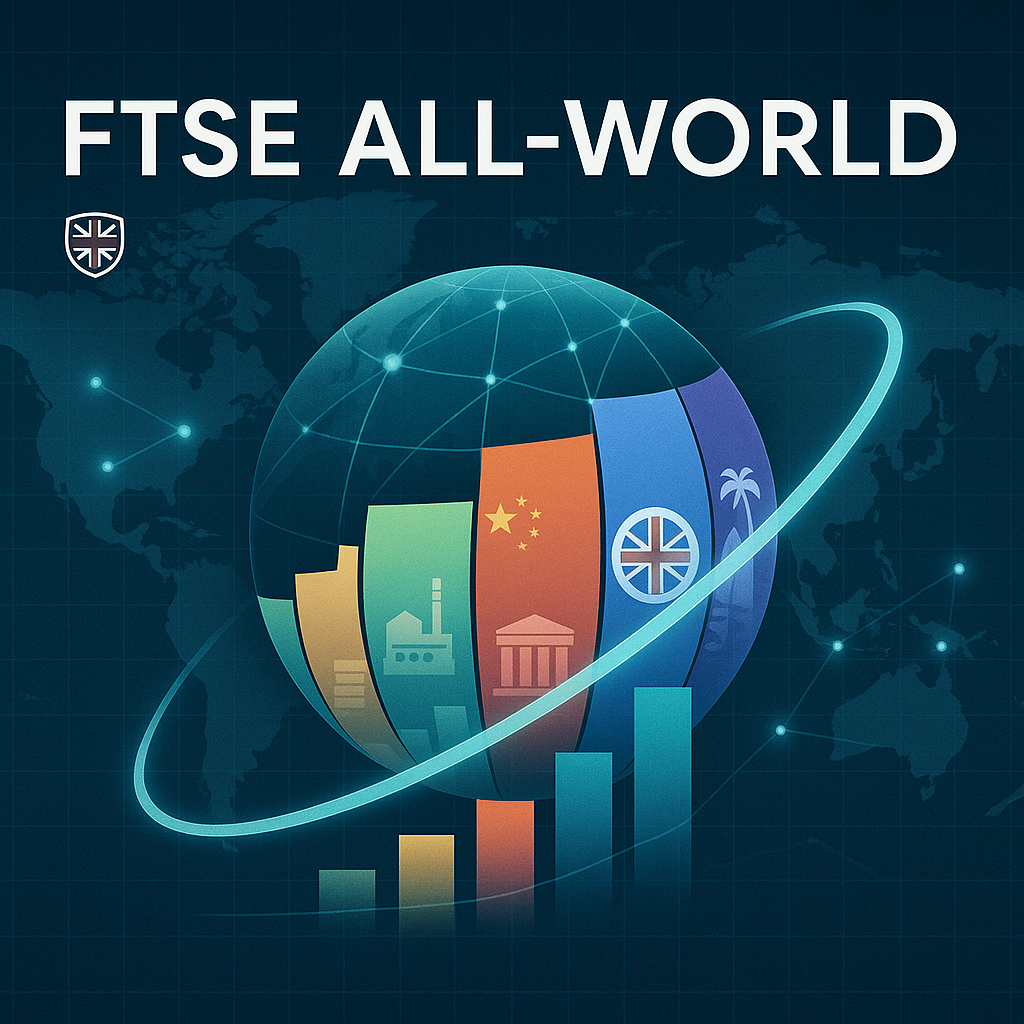FTSE All-World, a global equity benchmark, covers large- and mid-cap stocks from both developed and emerging markets—thereby offering investors a single, free-float-weighted gauge of roughly 95 % of the investible world market capitalisation. Consequently, the FTSE All-World serves as the default yard-stick for anyone seeking broad, country-agnostic equity exposure.

1. Quick Snapshot (May 2025)
| Metric | Value | Transition Note |
|---|---|---|
| Constituents | ~4 100 companies | To begin with, depth spans every major market. |
| Countries | 49 (23 DM, 26 EM) | Meanwhile, geographic reach remains unmatched. |
| Total Market Cap | US $68 trillion | Thus, scale dwarfs regional indices. |
| Developed / Emerging Split | 89 % / 11 % | Accordingly, EM weight still matters. |
| Dividend Yield | 1.9 % | Therefore, income complements growth. |
| Launch Year | 1994 | Finally, a 30-year history aids back-tests. |
| Currency | USD (local and other FX series available) | Hence, performance can be viewed in multiple bases. |
2. Inclusion Rules
| Rule | Detail | Transition Note |
|---|---|---|
| Size Cut-off | Top 90–95 % of each country’s free-float market cap | First and foremost, only liquid names enter. |
| Liquidity Screen | Minimum median turnover; free-float share > 5 % | Consequently, investibility is preserved. |
| Free-Float Adjustment | Inside ownership excluded; caps for strategic stakes | Moreover, control blocks don’t distort weight. |
| Weighting | Pure free-float market cap, no regional caps | Thus, larger economies naturally dominate. |
| Review Schedule | Quarterly (Mar, Jun, Sep, Dec) | Ultimately, the FTSE All-World stays current. |
3. Regional & Sector Weights
| Region | Weight* | Sector Leaders | Transition Note |
|---|---|---|---|
| United States | 61 % | Tech, Health Care | Chiefly, mega-caps set the tone. |
| Europe ex-UK | 14 % | Industrials, Financials | Meanwhile, cyclicals provide ballast. |
| Asia-Pacific ex-Japan | 9 % | Consumer, Tech | Additionally, demographic growth fuels demand. |
| Japan | 6 % | Industrials, IT | Likewise, restructuring boosts ROE. |
| Emerging Markets | 10 % | Banks, Internet | Hence, catch-up growth remains a lever. |
*April 2025, with the largest single-stock weight capped near 5 %.
Because U.S. names dominate, the FTSE All-World reflects dollar-centric leadership; nevertheless, sizeable pockets of diversification persist.
4. Recent Performance (USD)
| Year | Total Return | Key Drivers | Transition Note |
|---|---|---|---|
| 2022 | –17.6 % | Global rate shock | Initially, tightening weighed heavily. |
| 2023 | +21.1 % | Tech rebound, China reopening | Subsequently, risk appetite revived. |
| 2024 | +12.3 % | AI hardware boom, EM recovery | Moreover, secular themes kicked in. |
| YTD 2025 | +5.9 % | Stable rates, U.S. earnings beats | So far, macro stability supports gains. |
Five-year annualised return sits at 8.7 %, while volatility averages 15 %—therefore, risk-adjusted metrics remain attractive.
5. Why Investors Use the FTSE All-World
- Comprehensive Global Beta. One ticker captures ~95 % of investible market cap; consequently, allocation headaches fade.
- Benchmarking. Active global-equity funds measure alpha versus this neutral yard-stick; thus, performance claims stay transparent.
- ETF Underpinning. Low-cost trackers (e.g., VWRA, VWRL) replicate the FTSE All-World, thereby delivering instant diversification.
- Asset-Allocation Models. CIOs plug index returns into capital-market assumptions; as a result, strategic mix decisions hinge on its history.
6. Strengths & Caveats
| Strengths | Caveats |
|---|---|
| Broadest practical coverage of global equities. | However, the U.S. dominates (> 60 %), reducing regional balance. |
| Quarterly reviews keep the basket current. | Excludes small caps, therefore omits ~5 % of global float. |
| Free-float adjustment improves investibility. | EM liquidity screens limit frontier exposure. |
7. Emerging Trends to Watch
- ESG Tilt. FTSE now offers All-World Climate and All-World ex-Fossil Fuel offshoots; hence, sustainability goals become investible.
- Small-Cap Inclusion Debate. Asset owners lobby for FTSE All-World + Small-Cap to reach 99 % coverage, potentially broadening opportunity sets.
- China A-Share Weighting. Further inclusion phases could lift EM share toward 15 %, thereby diluting U.S. weight.
- Tokenised Delivery. Pilot on-chain versions aim to cut settlement latency for global-equity baskets; ultimately, trading hours may extend.
Key Takeaways
The FTSE All-World condenses large- and mid-cap equities from 49 countries into one investible benchmark. As of May 2025, it houses ~4 100 stocks, sports a 61 % U.S. weight, yields 1.9 %, and posts a five-year annualised return near 9 %. Ultimately, the FTSE All-World remains the go-to yard-stick for global-equity portfolios, multi-asset models, and passive ETFs—though investors should stay cognisant of its U.S. tilt and absence of small caps.